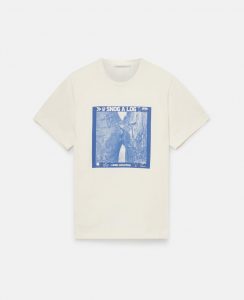The commonly observed trickle-down effect suggests the promising runoff effects of luxury fashion houses undertaking sustainability initiatives.
This phenomena occurs when a fashion trend moves from the runway, tailored to higher-status consumers, to the early adopter segment with a high need for status, then finally to the mass market (Bellezza & Berger, 2019).
However, consumers may perceive eco-friendly products to be less status-increasing than non-sustainable luxury products (De Kerviler et al., 2021).
How can high fashion brands overcome this perception through positioning?
Stella McCartney as the Blueprint
Stella McCartney is a brand famously known for committing wholeheartedly to green initiatives. They have recently developed a pilot project in collaboration with SÖKTAŞ using UNECE blockchain technology to verify sustainability metrics throughout the value chain (Stella McCartney, 2025). The technology uses highly complex methods such as satellite imagery and environmental DNA to allow traceability and transparency of the regenerative practices used (UNECE, 2023).
Other high-end fashion houses, such as Chanel, have committed to climate and sustainability goals, but have lagged behind on developing public-facing transparency tools — there is a clear information asymmetry between the brand and consumer (Chanel, 2025).

Why Innovate, and Why Tech?
The use of blockchain technology builds trust with consumers through full visibility. This creates opportunities to initiate micromarketing to customize messaging to specific consumers. Imagine receiving a personalized email outlining the lifetime journey of your recently purchased garment and how this would influence your perception of its value.
Blockchain technology is also important in future-proofing a fashion brand. Acting as a leader in sustainability innovations will undoubtedly grant Stella McCartney a head start on aligning with growing consumer demand for accountability.
Untapped Potential of Status Signalling
Status is a crucial piece to the puzzle when positioning luxury brands. Consumers develop social hierarchies based on differences in economic, cultural, and social capital, and many times will purchase a product simply due to the message it conveys (Bellezza, 2022).
As conspicuous consumption to achieve this higher level of status has become more mainstream, alternative status signals have emerged, including sustainable luxury and minimalism (Bellezza, 2022).
Turning Sustainability into a Must-Have
Dematerialization and digitalization are two emerging trends related to the quantity dimension of alternative status signals (Bellezza, 2022).
Consumers may move towards brands that reduce their use of raw materials, like Stella McCartney’s bio-based materials made from mushroom leather, or that streamline their processes for less wasteful production. As previously mentioned, leveraging digital marketing using data collected from blockchain technology is an avenue to explore.
The trends suggest that the demand for sustainable luxury is there (Am et al., 2023). Now, fashion brands need to focus their efforts on proving to their target market that their offerings don’t simply help the environment, but that it can also increase their social status.
Chanel. (2025). Sustainability Ambition. https://www.chanel.com/ca-en/sustainability/

I think this blog brings up a really important topic of the need for fashion brands, including luxury brands to begin the shift towards more sustainable products and processes. It will be interesting to see how the current socio-political context will affect consumers with a high need for status perceptions on sustainability as a status signal. I wonder if as the mainstream potentially moves farther away from sustainability if this effect can still be achieved, or if brands will have to market their sustainability utilizing different methods. The use of technology to track a product throughout the value chain and open up complete transparency to the consumer is super exciting, and I think an important step in the right direction to achieving sustainability on all fronts in the fashion industry. Overall I thought this blog was super informative and interesting to read!
I found the Stella McCartney pilot blockchain project very interesting as I was unaware that they would be able to track clothing through high tech practices such as satellites and environmental DNA. I think receiving an email about a garments lifetime would make me perceive it as more valuable as I would have an insight into where it came from and the many different people involved in the process. My question for you is how should brands ensure that people would only buy this in a sustainable way and not in an overconsumption or status seeking way?